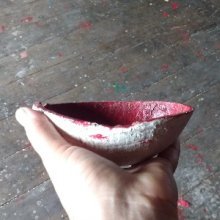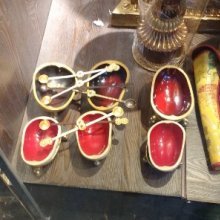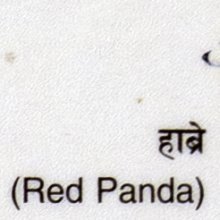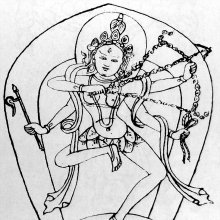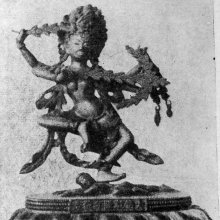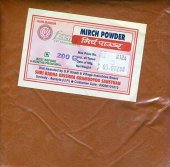Red, Reḍ: 6 definitions
Introduction:
Red means something in Hinduism, Sanskrit. If you want to know the exact meaning, history, etymology or English translation of this term then check out the descriptions on this page. Add your comment or reference to a book if you want to contribute to this summary article.
Images (photo gallery)
(+99 more images available)
In Hinduism
Natyashastra (theatrics and dramaturgy)
Source: Shodhganga: Elements of Art and Architecture in the Trtiyakhanda of the Visnudharmottarapurana (natya)1) The Red (colour) is denoted by the Sanskrit word Rakta and is associated with Raudra or the “furious sentiment”, which represents one of the nine kinds of Rasa (“soul of Drama”), according to the Viṣṇudharmottarapurāṇa, an ancient Sanskrit text which (being encyclopedic in nature) deals with a variety of cultural topics such as arts, architecture, music, grammar and astronomy.—The Viṣṇudharmottarapurāṇa relates that raudra is the sentiment that arises from anger. Krodha is the sthāyibhāva of raudra-rasa. Rakta i.e., red is the colour and Rudra is the God of this sentiment.
2) The Red color is associated with Catura-hasta: one of the twenty-two Single-hand Gestures (in Indian Dramas) (known as asaṃyuktahastas).—According to the Viṣṇudharmottarapurāṇa, some colours are pointed with the catura hand gesture. When the hand is raised in catura posture, it denotes white colour. When the hand moves in circular way and in semi-circular motion in caturahasta, it denotes yellow and red colour respectively. In compacted form it shows blue colour. When the hand is kept in normal position with caturahasta, it denotes black and the other remaining colours.

Natyashastra (नाट्यशास्त्र, nāṭyaśāstra) refers to both the ancient Indian tradition (shastra) of performing arts, (natya—theatrics, drama, dance, music), as well as the name of a Sanskrit work dealing with these subjects. It also teaches the rules for composing Dramatic plays (nataka), construction and performance of Theater, and Poetic works (kavya).
Shilpashastra (iconography)
Source: Shodhganga: Elements of Art and Architecture in the Trtiyakhanda of the Visnudharmottarapurana (shilpa)The Red color is associated with various deites, whose iconography is described in the Viṣṇudharmottarapurāṇa, an ancient Sanskrit text which (being encyclopedic in nature) deals with a variety of cultural topics such as arts, architecture, music, grammar and astronomy.—In the Viṣṇudharmottarapurāṇa, the attire, accessories, weapons, carrier, different colours etc. of the idols of different deities are projected which are taken for discussion here. It is clear that the book offers a great field of knowledge regarding the nuances of Indian art of Image making [e.g., the various colours for garments] during 10th–11th century A.D.
Red colour of Yama’s attire.—In the Viṣṇudharmottarapurāṇa, it is suggested that the garment of Yama should be in the colour of heated gold. But according to the Kāśyapaśilpa, the image of Yama should be adorned with red attire. Śilparatna also admits it.
Red colour of Agni’s body complexion.—Explaining the aṅgiras term Aitareyabrāhmaṇa says that aṅgiras is that which possesses aṅgāra i.e., charcoal—Charcoal in heated form is red in colour. So it can be assumed that following this concept of the Ṛgveda, the Viṣṇudharmottarapurāṇa suggests red colour as the body complexion of the image of Agni.

Shilpashastra (शिल्पशास्त्र, śilpaśāstra) represents the ancient Indian science (shastra) of creative arts (shilpa) such as sculpture, iconography and painting. Closely related to Vastushastra (architecture), they often share the same literature.
Languages of India and abroad
Sanskrit dictionary
Source: Cologne Digital Sanskrit Dictionaries: Monier-Williams Sanskrit-English DictionaryReḍ (रेड्):—or reL [class] 1. [Ātmanepada] reLate, to be angry (= krudhyati), [Naighaṇṭuka, commented on by Yāska ii, 12] (only in a-reḍat = anādaram akurvat, [Taittirīya-saṃhitā [Scholiast or Commentator]])
[Sanskrit to German]
Sanskrit, also spelled संस्कृतम् (saṃskṛtam), is an ancient language of India commonly seen as the grandmother of the Indo-European language family (even English!). Closely allied with Prakrit and Pali, Sanskrit is more exhaustive in both grammar and terms and has the most extensive collection of literature in the world, greatly surpassing its sister-languages Greek and Latin.
Nepali dictionary
Source: unoes: Nepali-English DictionaryRed is another spelling for रड [raḍa].—n. (iron) rod;
Nepali is the primary language of the Nepalese people counting almost 20 million native speakers. The country of Nepal is situated in the Himalaya mountain range to the north of India.
See also (Relevant definitions)
Starts with (+28): Red alder, Red almond, Red aloe, Red amaranth, Red amaranthus, Red ammannia, Red angola copal, Red arrow, Red arrow-leaf, Red arsenic, Red ash, Red azalea, Red baneberry, Red barberry, Red bauhinia, Red bay, Red bead plant, Red bead tree, Red bean, Red bean tree.
Query error!
Full-text (+6202): Lohita, Rakta, Rohita, Sindura, Raktacandana, Gairika, Raktambara, Raktavarna, Aruna, Manjishtha, Shona, Raktaka, Kashaya, Tamra, Raktotpala, Rudhira, Shonita, Patala, Manahshila, Raktadhatu.
Relevant text
Search found 470 books and stories containing Red, Reḍ; (plurals include: Reds, Reḍs). You can also click to the full overview containing English textual excerpts. Below are direct links for the most relevant articles:
Brihat Jataka by Varahamihira [Sanskrit/English] (by Michael D Neely)
Verse 27.3 < [Chapter 28 - Conclusion]
Verse 2.5 < [Chapter 2 - Planets]
Verse 27.1 < [Chapter 28 - Conclusion]
Kathasaritsagara (the Ocean of Story) (by Somadeva)
The use of turmeric (kuṅkuma) in ancient India < [Notes]
Part 19 - The Solomon Islands < [Appendix 8.2 - The Romance of Betel-Chewing]
Note on Ṭiklī, Tilaka and the uses of vermilion or red lead < [Notes]
Proportional Representation < [January-February, 1930]
Gardener < [April – June, 1988]
The Tension is Eased < [October 1955]
Shurangama Sutra (with commentary) (English) (by Hsuan Hua)
Space takes on the color of precious things < [Chapter 2 - The Form Skandha]
The false view of individual karma < [Chapter 2 - The Two False Views]
The Buddha manifests portents in response < [Chapter 2 - Twenty-five Means to Enlightenment]
World Journal of Pharmaceutical Research
Ayurvedic management of colour blindness < [2016: Volume 5, October issue 10]
An overview to some natural colouring agents used in pharmaceutical formulations < [2014: Volume 3, May issue 3]
Synthesis and characterization of azo-4,6-dipropionylresorcinol derivatives. < [2015: Volume 4, June issue 6]
Bhagavata Purana (by G. V. Tagare)
Chapter 7 - The Life of Bharata < [Book 5 - Fifth Skandha]
Chapter 53 - Rukmiṇī’s Marriage: Rukmiṇī carried away by Kṛṣṇa < [Book 10 - Tenth Skandha]
Notes regarding the Vyūhas (manifestations of God) < [Appendices]
Related products
(+75 more products available)

